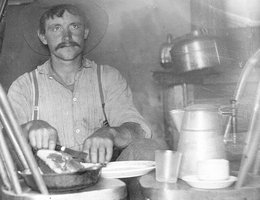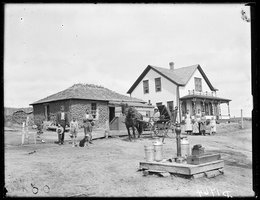

So, what was it like to live in a sod house? Some people found life in a sod house unendurable, others felt like they were on top of the world. It is difficult to judge the way of life by today’s standards because each person looked at their life in a slightly different way.
For example, dirt floors were found in the majority of the early sod homes. A family that could afford them might fasten carpets to the dirt floor. In some cases, rough or planed split logs were used for flooring. But only a few could afford the luxury of wide, roughcut planks from the sawmill. Some women protested against the continual war with dirt, bugs, snakes, leaky roofs and poor lighting. Nothing ever seemed to be clean. Others seemed to take the conditions in stride.
On the day she and moved into her new sod house, Mattie Oblinger wrote to her family back east. She had only minor complaints about sod house living and seemed excited by her new life.
Mrs. O.C. Bell remembered the sod house experience with less fondness. In the late 1930s she told researchers from the Federal Writers Project about her life and some of the songs that were written about the sod house frontier.

In the late 1930s she told researchers from the Federal Writers Project about her life and some of the songs that were written about the sod house frontier.
Because of the thickness of the walls and in insulating ability of the material, sod houses did an excellent job of keeping the heat of a stove in the house during winter. They also helped keep the heat out during the summer. Several stories from folks who lived in sod houses sing the praises of a house that is "Cheap, cool in summer, warm in winter," as a Mr. Swisher of Halsey told the State Historical Society in 1932. "The sod house laughs at hard times and keeps alive old traditions."
Others tell of a school built of sod where, "The floor was of dirt and during the cold winter of 1884 the teacher’s feet were frosted. Later a quantity of straw was put on the floor which made it warmer but proved to be a breeding place for fleas. This was not conductive to quiet study but did afford the children some bodily activity." (Isabel Fodge Cornish, in Pioneer Stories of Custer County, Nebraska, collected by Emerson R. Purcell.)
Settler families tended to live in their sod houses six or seven years. If the exterior was covered over with whitewash or stucco, the houses could last much longer. But sod construction had it’s limits. Look at the photograph at left.
Imagine these nine people living in the sod house in front. Remember that the walls on the soddy are three feet or so thick. There was probably only one room with one door and perhaps four windows. Then look at the wood frame house in the background. Then imagine the number of rooms in the wood frame house in the background. Is it any wonder that wood frame houses became popular?